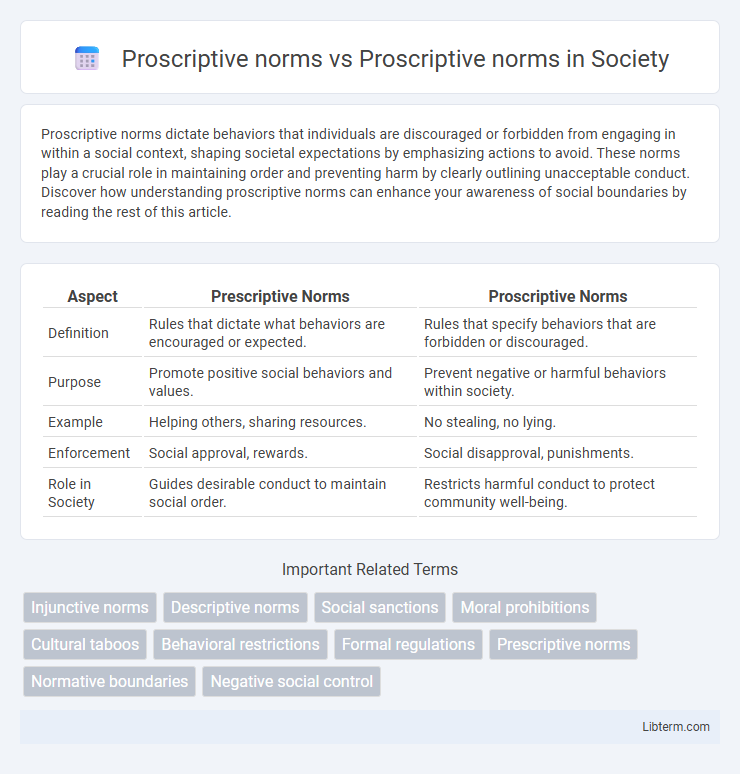Proscriptive norms dictate behaviors that individuals are discouraged or forbidden from engaging in within a social context, shaping societal expectations by emphasizing actions to avoid. These norms play a crucial role in maintaining order and preventing harm by clearly outlining unacceptable conduct. Discover how understanding proscriptive norms can enhance your awareness of social boundaries by reading the rest of this article.
Table of Comparison
| Aspect | Prescriptive Norms | Proscriptive Norms |
|---|---|---|
| Definition | Rules that dictate what behaviors are encouraged or expected. | Rules that specify behaviors that are forbidden or discouraged. |
| Purpose | Promote positive social behaviors and values. | Prevent negative or harmful behaviors within society. |
| Example | Helping others, sharing resources. | No stealing, no lying. |
| Enforcement | Social approval, rewards. | Social disapproval, punishments. |
| Role in Society | Guides desirable conduct to maintain social order. | Restricts harmful conduct to protect community well-being. |
Understanding Proscriptive Norms: Definition and Importance
Proscriptive norms are social rules that dictate what behaviors are forbidden or discouraged within a community, helping to maintain order and prevent harm. Understanding proscriptive norms is crucial because they guide individuals in avoiding actions that are considered unacceptable or morally wrong, thus fostering social cohesion. These norms function alongside prescriptive norms, which suggest desirable behaviors, highlighting the importance of recognizing both to navigate societal expectations effectively.
Proscriptive vs Prescriptive Norms: Key Differences
Proscriptive norms dictate behaviors individuals should avoid, serving as social boundaries that restrict unacceptable actions, while prescriptive norms guide acceptable and encouraged behaviors within a society. Proscriptive norms often carry stronger social sanctions to prevent harmful or taboo behaviors, whereas prescriptive norms promote positive conduct and cooperation. Understanding the distinction between proscriptive and prescriptive norms is critical for analyzing social regulation and cultural expectations effectively.
Historical Development of Proscriptive Norms
Proscriptive norms have evolved through historical societies as rules that explicitly forbid certain behaviors, ensuring social order by creating clear boundaries of unacceptable conduct. Their development can be traced back to ancient civilizations, where codified laws and religious doctrines established prohibitions critical for community cohesion. Over time, these norms adapted alongside cultural shifts, influencing modern legal systems and social expectations by maintaining collective moral standards through prohibitions.
Sociocultural Influences on Proscriptive Norms
Proscriptive norms, which dictate behaviors that individuals should avoid, are heavily shaped by sociocultural influences such as traditions, religious beliefs, and social hierarchies within a community. These norms often reflect collective values and moral codes, reinforcing conformity by prescribing penalties or social sanctions for violations. Understanding the sociocultural context is essential for analyzing how proscriptive norms maintain social order and influence individual behavior across diverse societies.
Common Examples of Proscriptive Norms in Society
Proscriptive norms in society commonly include prohibitions against theft, violence, and dishonesty, which serve to maintain social order and safety. These norms dictate behaviors that individuals must avoid to prevent harm and ensure trust within communities. Violating proscriptive norms often results in social sanctions, reinforcing the importance of adherence for societal cohesion.
The Role of Proscriptive Norms in Shaping Behavior
Proscriptive norms play a critical role in shaping behavior by clearly defining what actions are unacceptable or forbidden within a social group. These norms enforce compliance through social sanctions, guiding individuals to avoid behaviors that could lead to disapproval or punishment. Understanding the impact of proscriptive norms helps explain how social order is maintained by restricting undesirable conduct.
Legal Implications of Proscriptive Norms
Proscriptive norms, which dictate behaviors individuals must avoid, carry significant legal implications by often forming the basis of criminal laws and regulations that prohibit certain actions to maintain social order. Violations of these norms typically result in legal sanctions such as fines, imprisonment, or other penalties designed to deter harmful conduct and protect public welfare. Understanding the enforcement mechanisms of proscriptive norms helps in analyzing how legal systems operationalize societal values through codified prohibitions.
Proscriptive Norms in the Workplace
Proscriptive norms in the workplace refer to behaviors and actions that are explicitly forbidden or discouraged, ensuring a professional and respectful environment. These norms prevent misconduct such as harassment, discrimination, and unethical practices, promoting organizational integrity and employee well-being. Adhering to proscriptive norms supports compliance with legal standards and fosters a culture of accountability.
Changing Trends in Proscriptive Norms
Changing trends in proscriptive norms reflect evolving societal boundaries on unacceptable behaviors, driven by cultural shifts, technological advancements, and increased awareness of individual rights. These norms, previously rigid and often enforced through formal and informal sanctions, now exhibit flexibility as diverse communities challenge traditional moral codes and advocate for inclusivity. The dynamic nature of proscriptive norms illustrates normative adaptation, highlighting the complex interaction between social control mechanisms and contemporary social values.
Challenges and Criticisms of Proscriptive Norms
Proscriptive norms, which dictate behaviors to avoid, often face criticism for fostering rigidity and inhibiting individual freedom by imposing strict social constraints. These norms can create challenges in diverse societies where differing values and cultural practices make uniform prohibitions difficult to enforce and sometimes lead to social exclusion or stigmatization. Furthermore, the enforcement of proscriptive norms may result in unintended consequences such as resistance, misunderstanding, or social conflict due to their prescriptive nature.
Proscriptive norms Infographic

 libterm.com
libterm.com